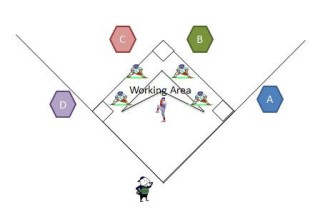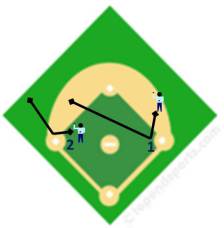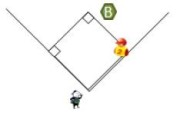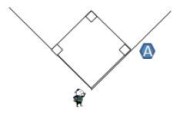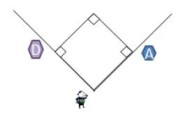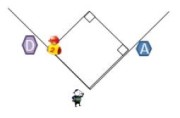Base Umpiring Essentials
How do I get into position to make the call on a runner?
The short answer: Making accurate calls starts with getting to the right place at the right time and where you have a better view of the play than anyone else. There are different techniques you can use to help you get there.
Track the ball and anticipate where the play is going
- Once the ball is hit, quickly glance and track where it is going and where the fielder throws it to. You want to quickly decide where the play is going and the throwing lane to make sure you stay out of the way of the ball as you move into position.
Move into position using the “inside / outside” technique
Face "chest-to-ball" and reverse pivot to the play once the ball is thrown
- Quickly after a hit, jog to the position where you want to make the call from, with your chest facing to the ball. When the fielder releases the ball, you should then reverse pivot on your foot to observe the play at the base / runner. The videos below show examples of these techniques.
- For balls hit into the outfield, you have more time to get into position and get set, so the timing of the reverse pivot is not as crucial as it is with balls hit and fielded within the infield.
Regardless of your position to a play, try to be stationary at the time the play happens
- Try to be about 10 feet or so from a play being made on a runner and at a good view angle (90 degrees is ideal) from the throw to where the play will be made.
- The picture shows two examples of view angles on plays.
- #1 - force out play at 1B, throw from SS, after moving from the A slot
- #2 - tag play at 3B, throw from LF, after moving from the C slot
- Sometimes the ideal is not possible so favor angle over distance, and be stationary at the time the play happens. You want to be firmly set, not moving, when it’s time to make your call.
Move Into position to make your call – Examples
- Below are some examples of the mechanics described in this section.
Two person crew ("going inside") video
- Runner on 1st base (1B). Base Umpire (BU1) starts in B Slot.
- Ball hit into the outfield.
- BU1 moves from B Slot into the Working Area to make the call at 2nd base (2B).
Two person crew ("going inside") video
- No runners on base – BU1 starts in A Slot.
- A fly ball is it to an outfielder who throws to 2B to attempt an out on the batter-runner attempting a double.
- BU1 moves from A Slot into the working area in front of 2B to make the call at 2B.
Three person crew ("staying outside") video
- No runners on base – BU1 starts in A Slot. BU2 starts in D Slot.
- A grounder is hit to an infielder who throws to 1B.
- BU1 moves (staying outside the baseline) into the area to the left of 1B to make the out/safe call at 1B.
Three person crew ("going inside") video
- Runner on 3rd base (3B) – BU1 starts in A Slot. BU2 starts in D Slot.
- A fly ball is hit to an outfielder who throws to 2B to attempt an out on the batter-runner attempting a double.
- BU2 moves from D slot into the working area in front of 2B to make the call at 2B.
Next up: How do I call a runner out or safe?



